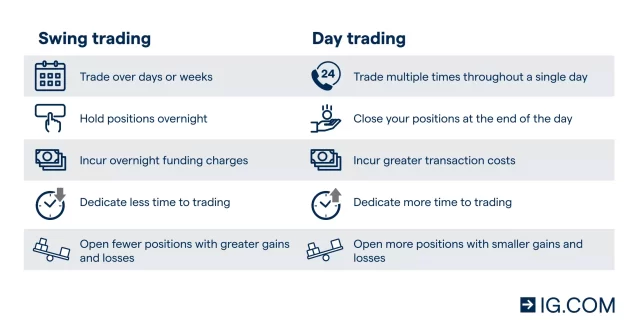In the realm of financial markets, two prominent strategies are employed by traders to capitalize on price movements: swing trading and day trading. Each approach has its own set of principles, techniques, and potential for profitability. A comparison of swing trading and day trading in terms of profitability, risk, and time commitment will be conducted to determine which strategy might be more advantageous for traders.
Understanding Swing Trading
Swing trading involves holding positions for several days to weeks, capitalizing on short to medium-term price movements. Unlike day trading, where positions are closed before the market closes, swing traders aim to capture price swings within the broader trend. Technical analysis is heavily relied upon, with charts and indicators used to identify potential entry and exit points.
The profitability of swing trading is influenced by various factors, including market conditions, the trader’s skill in identifying trends, and the effectiveness of risk management strategies. Swing trading allows for more flexibility in trading hours, as it does not require constant monitoring of the market. This approach is often considered less stressful compared to day trading, as it avoids the pressure of making quick decisions within a single trading day.
Understanding Day Trading
Day trading, on the other hand, involves buying and selling securities within the same trading day. Positions are not held overnight, minimizing the risk of adverse price movements after market hours. Day traders seek to profit from small price fluctuations by executing multiple trades throughout the day. Advanced technical analysis, real-time market data, and fast execution platforms are essential for success in day trading.
The potential for high profitability exists in day trading, but so does the risk. A significant amount of time and effort is required to monitor the markets continuously. The high frequency of trades can lead to substantial transaction costs, which can eat into profits. Additionally, the emotional stress associated with day trading can be considerable, as rapid decision-making under pressure is required.
Profitability Comparison
The profitability of swing trading versus day trading can vary widely depending on several factors, including market conditions, the trader’s skill level, and the strategies employed.
- Market Conditions: During volatile market conditions, day trading can be more profitable due to the higher number of trading opportunities. However, in a trending market, swing trading can yield substantial profits as traders capture larger price movements.
- Skill Level: The skill and experience of the trader play a crucial role in determining profitability. Day trading requires a higher level of expertise and quick decision-making abilities. Swing trading, while also requiring a good understanding of market trends, allows for more deliberation and analysis before making trades.
- Strategies Employed: Different strategies can be employed in both swing trading and day trading. For instance, momentum trading can be used in both approaches, but the time frames and execution will differ. The effectiveness of these strategies depends on the trader’s ability to implement them successfully.
Risk and Reward
The risk and reward profile of swing trading and day trading differ significantly.
- Swing Trading: The risk in swing trading is mitigated by the longer holding periods, which allow for more considered decision-making. However, the potential for overnight risk exists, where news or events can lead to significant price gaps against the trader’s position. The reward in swing trading can be substantial due to the potential to capture larger price movements.
- Day Trading: The risk in day trading is elevated due to the high frequency of trades and the need for rapid decision-making. However, the overnight risk is eliminated as positions are closed before the market closes. The reward can be high due to the potential for multiple profitable trades within a single day, but transaction costs and emotional stress can reduce overall profitability.
Time Commitment
The time commitment required for swing trading and day trading is another crucial factor to consider.
- Swing Trading: This approach requires less time commitment compared to day trading. Traders can spend a few hours each day or week analyzing the markets and making trades. This makes swing trading more suitable for individuals who have other commitments and cannot dedicate their entire day to trading.
- Day Trading: A significant time commitment is required for day trading, as traders need to monitor the markets continuously throughout the trading day. This approach is more suitable for individuals who can dedicate full-time hours to trading and have the capacity to handle the associated stress.
Conclusion
Both swing trading and day trading have the potential to be profitable, but the choice between the two depends on the trader’s risk tolerance, time commitment, and skill level. Swing trading offers more flexibility and lower stress, making it suitable for part-time traders. Day trading, while potentially more profitable in volatile markets, requires a higher level of expertise, time commitment, and the ability to handle emotional stress.
The profitability of either strategy cannot be guaranteed, as success in trading depends on various factors, including market conditions and the trader’s ability to implement effective strategies. Therefore, traders should carefully consider their personal circumstances and preferences before choosing between swing trading and day trading.










